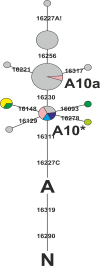MtDNA Haplogroup A10 Lineages in Bronze Age Samples Suggest That Ancient Autochthonous Human Groups Contributed to the Specificity of the Indigenous West Siberian Population
- PMID: 25950581
- PMCID: PMC4423966
- DOI: 10.1371/journal.pone.0127182
MtDNA Haplogroup A10 Lineages in Bronze Age Samples Suggest That Ancient Autochthonous Human Groups Contributed to the Specificity of the Indigenous West Siberian Population
Abstract
Background: The craniometric specificity of the indigenous West Siberian human populations cannot be completely explained by the genetic interactions of the western and eastern Eurasian groups recorded in the archaeology of the area from the beginning of the 2nd millennium BC. Anthropologists have proposed another probable explanation: contribution to the genetic structure of West Siberian indigenous populations by ancient human groups, which separated from western and eastern Eurasian populations before the final formation of their phenotypic and genetic features and evolved independently in the region over a long period of time. This hypothesis remains untested. From the genetic point of view, it could be confirmed by the presence in the gene pool of indigenous populations of autochthonous components that evolved in the region over long time periods. The detection of such components, particularly in the mtDNA gene pool, is crucial for further clarification of early regional genetic history.
Results and conclusion: We present the results of analysis of mtDNA samples (n = 10) belonging to the A10 haplogroup, from Bronze Age populations of West Siberian forest-steppe (V-I millennium BC), that were identified in a screening study of a large diachronic sample (n = 96). A10 lineages, which are very rare in modern Eurasian populations, were found in all the Bronze Age groups under study. Data on the A10 lineages' phylogeny and phylogeography in ancient West Siberian and modern Eurasian populations suggest that A10 haplogroup underwent a long-term evolution in West Siberia or arose there autochthonously; thus, the presence of A10 lineages indicates the possible contribution of early autochthonous human groups to the genetic specificity of modern populations, in addition to contributions of later interactions of western and eastern Eurasian populations.
Conflict of interest statement
Figures



References
-
- Bagashev AN (1998) Anthropological types, their systematization and specific features of their genesis // Outlines of cultural genesis of West Siberian Peolpes V.4: Genesis of racial features of indigenous populations. Tomsk: Tomsk University; P. 303–327. (in Russian).
-
- Chikisheva TA (2012) Dynamics of anthropological differentiation in population of southern part of Western Siberia in Neolithic—Early Iron Age Novosibirsk: IAET SB RAS. 468 p. (in Russian).
-
- Naumova OIu Rychkov SIu, Morozova IIu Khaiat SSh, Semikov AV Zhukova OV (2008) Mitochondrial DNA diversity in Siberian Tatars of the Tobol-Irtysh basin. Rus J Genet 44: 215–226. - PubMed
-
- Alexeev VP (1974) Geography of human races Moscow: Misl; `. 351 p. (in Russian).
Publication types
MeSH terms
Substances
LinkOut - more resources
Full Text Sources
Other Literature Sources

